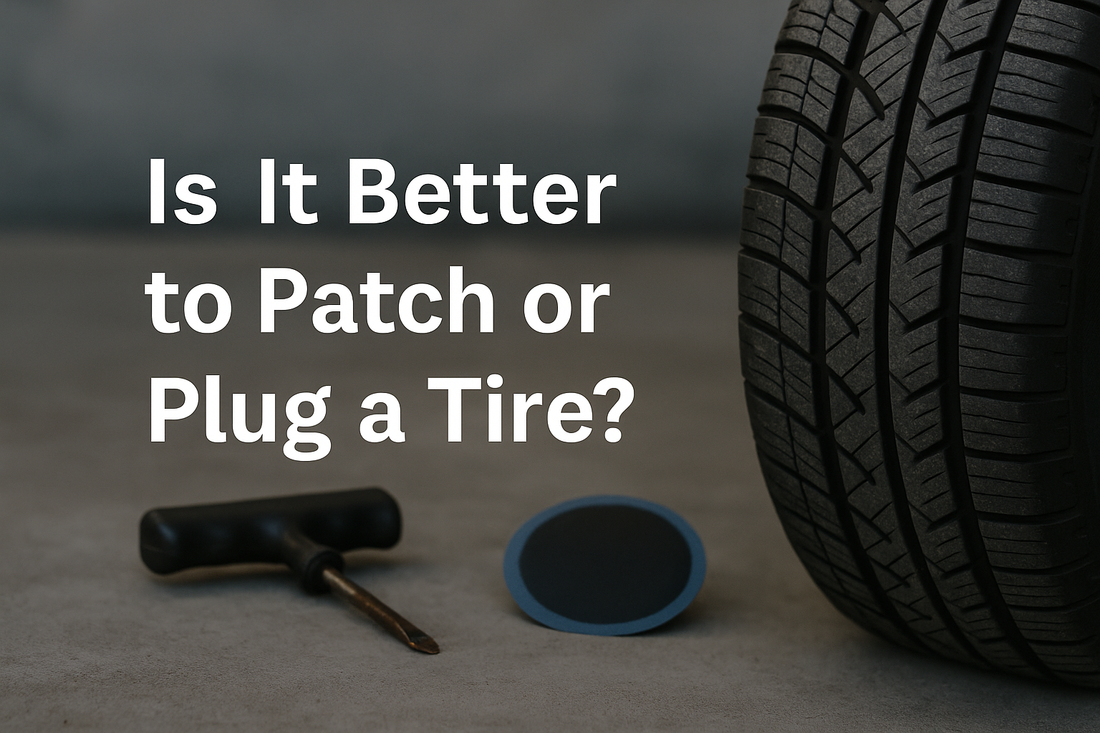
Is It Better to Patch or Plug a Tire? (Mechanic’s Honest Answer)
Share
Table of content
What Really Happens When Your Tire Takes a Hit: A Deep Dive into Tire Damage
Got a flat and stuck deciding whether to patch or plug your
tire? Here's the quick, no-BS answer: Patches are
safer, stronger, and built for the long haul, while plugs offer a cheap, speedy fix
for emergencies. If you’re cruising highways or want peace of mind, go patch or
plug-patch combo. But for small punctures and tight budgets, a plug can do the
trick temporarily. Let's break down exactly why.

Tread punctures
This is pretty much your classic flat-tire scenario. A sneaky nail, an evil screw, or even a shard of broken beer bottle glass decides your tire looks like a comfy new home. These tread punctures are annoyingly common but thankfully, fixable—if they're small, usually less than the width of your average pencil (around a quarter inch or so). If you catch these punctures early enough, you're golden and can usually avoid pricey replacements (DOT tire guidelines back me up here).
Sidewall damage
Oh, man—sidewall damage is a real bummer. You know that thinner, more flexible side part of your tire? Yeah, that's the sidewall, and it really hates potholes and sharp edges. Unfortunately, once it's damaged, that's usually it—game over. Time to wave goodbye and pick up a new tire, because sidewalls just don't heal well. Ever tried patching up a torn paper plate with glue? Exactly, pointless and messy.
Leaky valve stems
Valve stems don't seem important until they're hissing air at you. They might not give you that dramatic "pop!" moment, but these little leaks slowly sap air like your uncle draining the punch bowl at family parties. You'll wake up in the morning thinking you've got a slow puncture, but really it's just this little valve stem acting up. Easy enough fix usually, but definitely annoying.
So, What’s a Tire Plug, Anyway? 🔧
Ever had a flat in the middle of nowhere? You know, when it’s pouring rain and you’ve gotta be somewhere important in ten minutes flat (pun intended)? Enter tire plugs, your new best friend.
Think of a plug as a first-aid kit for your tire—it’s the quick fix, roadside-style. You grab a sticky strip of rubber, dunk it in adhesive, and shove it straight into that pesky hole from outside. No fancy tools or tire removal necessary.
Quick facts about tire plugs:
- Cheap fix: Like lunch-money cheap. Plug kits cost less than pizza night.
- Fast: Literally minutes to fix up and get rolling again.
- DIY-friendly: Even if you barely know a wrench from a screwdriver, you’ll figure this out pretty quick.
But hold your horses—plugs aren’t foolproof. Big punctures, weird angles, or long-term driving? Not your plug’s strongest moments.
What’s a Tire Patch Then? 🛞
Now, let’s say your tire took a bit more of a beating. Maybe a plug feels a bit too flimsy—like covering a deep cut with a tiny bandaid. You need something tougher, more trustworthy. You need a patch.
Unlike a quick plug, a patch goes on the inside. Yep, tire comes off the rim, and you (or a mechanic) get down-and-dirty buffing and sealing a hefty rubber pad against the inside wall. It sounds fancy because, well, it sorta is: it's called vulcanizing the patch. (Fancy word for melting rubber together in a permanent way.)
Patch highlights:
- Super durable: This fix usually outlives the rest of the tire.
- Recommended by pros: Tire companies swear by patches; they've been around forever.
- More expensive and slower: It takes longer and usually means shelling out cash at the mechanic’s.
Plug vs. Patch—What’s Really Different? ⚠️
| Factor | Tire Plug 🟡 | Tire Patch 🟢 |
|---|---|---|
| Installation | Quick and easy (outside job) | Slow, detailed (inside job) |
| Durability | Temporary fix, emergencies | Long-term solution |
| Safety | OK-ish for short trips | Solid, safe, highway-worthy |
| DIY potential | Yep, super DIY-friendly | Usually needs a pro |
| Costs | About $10–$20 | Usually around $20–$40 |
| Tire Warranty | Could void it | Usually warranty-approved |
| Best situations | Emergencies, small holes | Regular use, long-distance drives |
The Ultimate Combo Fix—Plug and Patch Together ✅
Sometimes you want belt-and-suspenders-level security. The plug-patch combo gives you just that. This fix hits both fronts: it plugs the external hole and seals from the inside, creating a strong and stable repair that's seriously reassuring.
You’ll pay extra for this peace-of-mind combo—usually
$40–$50—but it could be worth it if highway driving and tire integrity are high
on your list.
Brass Plug Patches from Tire Xperts
Tire Xperts Brass Plug patches are much superior in quality than other Stainless steel plug patches. Brass Rod has a higher corrosion-resistant value than stainless steel. It has higher temperature resistance and is highly durable, making your drive safe and providing complete protection to your car tires.
When’s a Good Time for Just a Plug? 🔧
Let's be practical. A tire plug is your buddy in a tight spot. Good situations to whip out a plug kit include:
- A clean, tiny puncture right in the middle of your tire tread.
- Roadside emergencies—when you absolutely need to move NOW.
- If you're broke or short on time and need a quick, budget-friendly fix.
Basically, tire plugs are your friend with benefits—handy, reliable in a pinch, but maybe not your first choice for the long haul.
When Should You Definitely Go with a Patch? 🛞
But patches? They’re more your committed partner. Here’s when a patch is clearly better:
- You drive regularly on highways or at higher speeds.
- That quick-and-dirty plug didn't hold as well as you'd hoped.
- You want a permanent fix. No shortcuts, no what-ifs.
Sure, patches take more time, but they're the grown-up choice. The payoff? Confidence. Less stress. And probably a safer ride overall.
What the Experts Say 🔧
When you're stuck roadside with a nasty puncture and trying to decide is it better to patch or plug a tire, you might wonder what the pros think. Mechanics, tire shops, and manufacturers—they've all got their opinions. Generally speaking, most tire companies lean toward patches or a plug-patch combo. Why? Well, patches handle the inside and plugs the outside—double trouble for punctures. Goodyear even states clearly on their tire maintenance guidelines that patches or combo repairs are their gold standard for fixing flats.
DIY vs. Professional Repair 🛞

So you're handy around cars and wondering if patching or plugging your tire at home is doable. Short answer: maybe.
For starters, plugging a tire is pretty doable for anyone comfortable around basic tools. Those plug kits you grab from the auto store? They're straightforward—jab in the rubber strip, twist, and yank out. Boom, done. But just 'cause you can doesn't always mean you should. Think of plugging your tire like making instant ramen—it’s cheap, quick, and simple. It’ll do in a pinch, but it’s not exactly Michelin-star tire care.
On the other hand, a proper tire patch or a plug-patch combo requires specialized tools and technique—usually meaning pro-level intervention. Patching involves removing your tire from the rim, inspecting it carefully, cleaning and prepping the inner lining, and vulcanizing (hot sealing) the patch securely.
Final Verdict – Patch or Plug? ✅
Alright, we've circled the block enough times—let’s settle the patch vs plug tire debate once and for all.
| Factors | Plug 🟡 | Patch 🟢 | Plug-Patch Combo 🔴 |
|---|---|---|---|
| Quickness | ✅ Minutes | ⚠️ 30–60 minutes | ⚠️ Slightly longer |
| Safety | ⚠️ Short-term okay | ✅ High | ✅ Highest |
| Durability | ⚠️ Temporary (months to a year) | ✅ Very durable | ✅ Excellent |
| DIY-friendly? | ✅ Yes, super easy | ❌ Nope, leave to a pro | ❌ Usually pro-only |
| Cost | ✅ Super cheap ($10–$20) | ⚠️ Moderate ($20–$40) | ⚠️ Higher ($40–$50) |
| Expert Preference | ⚠️ Mixed feelings | ✅ Recommended by tire makers | ✅ Strongly endorsed |
